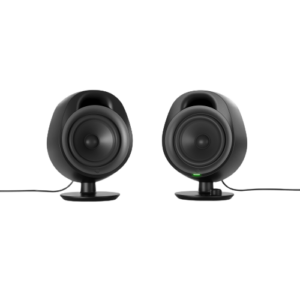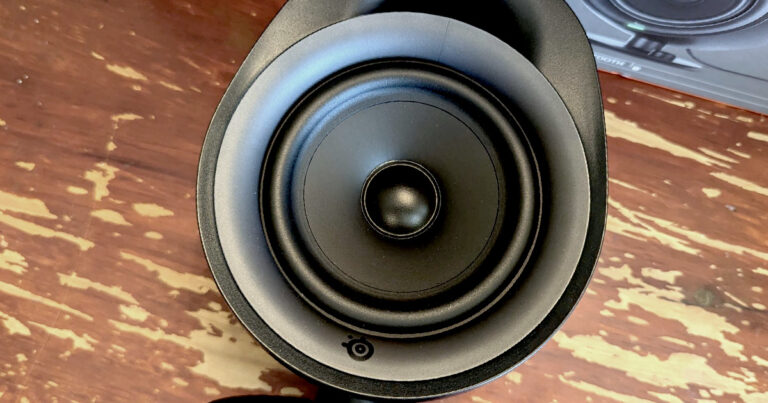Beautifully balanced sound comes at the cost of none-too-cheap single-purpose PC speakers.
SteelSeries Arena 3 speakers review
I can’t speak for anyone else, but I used to cheap out on my PC audio by investing in great headphones for gaming and then using tinny monitor speakers for everyday playback. Then multiple generations of Logitech speakers changed everything. Between those, Klipsch blew my mind (or should that be “ears”?) with their incredible quality before one of the speakers died.
More recently, I’ve been appreciating the practical slot-under-the-monitor space saving of soundbars, first with the solid Razer Leviathan V2 and then the even more impressive Creative Sound Blaster Katana V2. I’ve been spoiled for choice with more expensive higher-end speakers, so I was curious to see what the SteelSeries Arena 3’s more entry-level design could bring to the conversation.
SteelSeries Arena 3 value for money
For what they don’t offer in terms of versatility, the SteelSeries Arena 3 speakers aren’t cheap. The $289 RRP pushes pretty deep into 2.1 speaker pricing territory, with multiple cheaper options available from Logitech. If you can nab the SteelSeries Arena 3 for closer to $200, the value proposition becomes a lot better, but for PC speakers designed to primarily connect via 3.5mm jack, that price feels too steep.
SteelSeries Arena 3 design and ease of use
I fancy PC speakers that you can fit under a monitor or, at the very least, have the option to sit sideways beneath a screen. That’s not essential for every desktop configuration, but when you have three 27-inch monitors on your desk like I do, space is at a premium.
The SteelSeries Arena 3 speakers feature an attractive rounded design with their selling-point four-inch drivers front and centre. As they should be. The individual speaker stands make for easy desktop placement on flat surfaces, which means they’re clearly not made to lie down. Lift that main monitor or place these bad boys in flanking positions.
There’s a single 3.5mm port in the left speaker, which connects to the back of the right one. Behind the right speaker is also 3.5mm ports marked Headset, AUX and PC, with a DC power connector beside that. The power adaptor follows a similarly chonky design motif as the speakers, so you may have to shuffle adaptors on the power board if they’re close together.
It’s a nice touch that you can have PC sound and an attached headset for audio (Headset) and mic communications (AUX). But that’s also assuming you have a budget headset that uses 3.5mm connectors and not, say, the SteelSeries Arctis Nova Pro very-much-wireless headset instead. While there is a (discrete) power button and volume dial on the right speaker, a remote would be nice (even if it’s in smartphone app form).
SteelSeries Arena 3 soundscape testing
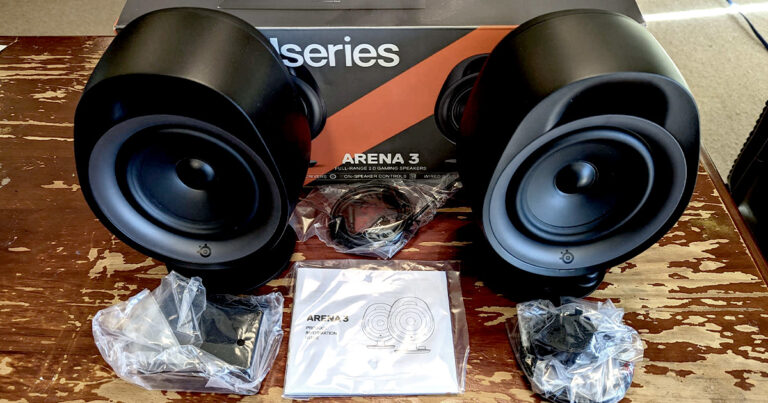
The SteelSeries Arena 3 speakers have mostly great tuning out of the box. That’s pretty important given the limited connectivity options. After all, those after high-quality audio aren’t typically reaching for speakers with a 3.5mm jack. That means there are no USB, optical or HDMI ARC ports.
Despite being ‘restricted’ to 16-bit sound, there’s still a richness to the overall soundscape. Whether listening to full orchestral soundtracks or rock anthems, the highs and mids are impressively detailed. It’s the lows that really suffer. While I was able to find certain tracks that made the lows stand out more prominently, they were mostly unimpressive in a way that had me itching to return to speakers with a subwoofer.
Volume-wise, you won’t have any issues getting the SteelSeries Arena 3 speakers to an uncomfortably loud place. That said, once you start pushing beyond 80% volume, distortion starts to creep in: only a bit at first, but the louder you go, the more noticeable it becomes.
SteelSeries Arena 3 software and equaliser settings
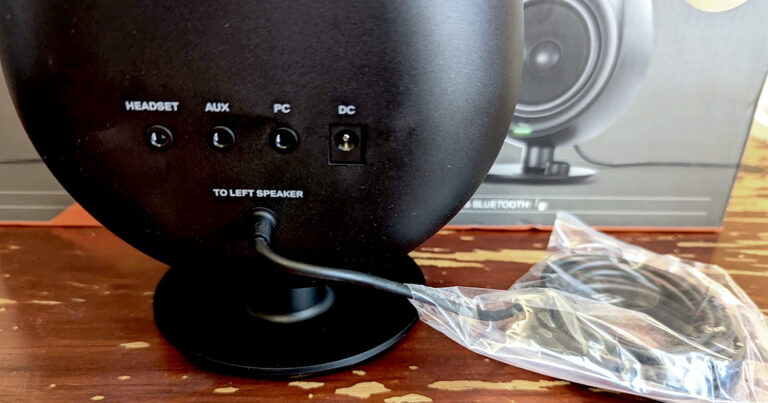
If you don’t want to use the 3.5mm jack, the SteelSeries Arena 3 speakers also support Bluetooth connectivity. That’s a necessary win on the connectivity-versatility front, but it’s also a missed opportunity for a SteelSeries companion app. Such an app would solve the problem of a missing remote, plus it would make it easier to personalise audio on the fly or flick between presets.
SteelSeries does have a workaround for this. Sort of. On PC, you can install SteelSeries GG and access tweaks via Sonar. Because there’s no USB connection between PC and speakers, though, the Arena 3 doesn’t show up in the Engine tab for straightforward updates and tweaks, and nor does it stand out as its own device in Sonar.
It doesn’t help that Sonar requires a user account just to use presets or tweak equaliser settings. Worse still, my Sonar tests didn’t really seem to impact the sound when shifting between multiple preset options. Additionally, Sonar seemingly capped the overall volume, which would only return to its full potential after exiting out of SteelSeries GG.
While this does feel like a bug, it’s the kind of thing that surely would have an easy fix if the Arena 3 speakers offered USB connectivity for firmware updates. Without that, you have to hope that SteelSeries GG is the problem and the issue can be fixed in a future software update.
Is the SteelSeries Arena 3 worth buying?
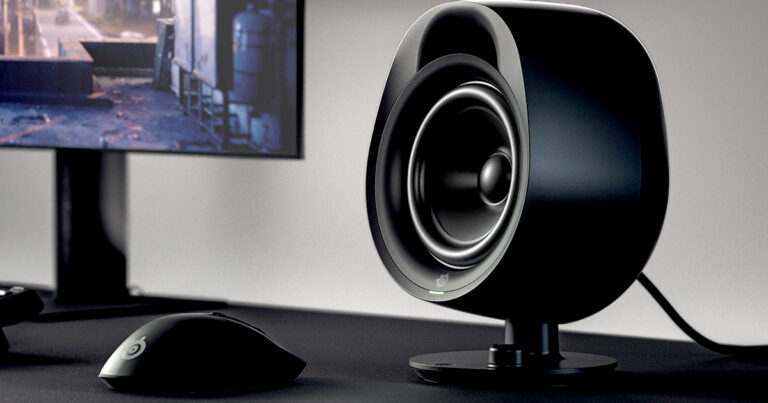
The SteelSeries Arena 3 speakers are tricky to wholeheartedly recommend. On one hand, there’s well-balanced plug-and-play audio out of the box with plenty of volume. On the other, it has a pricey RRP for a 2.0 configuration that’s light on connectivity options, making it a whole lot more single-purpose than I’d like. These speakers are worth considering if you can get them around $200, but there are better, more versatile options around.
How we review speakers
Our main focus with speakers is how they sound. This means we put them through the paces of everyday use, depending on what they’re designed for. If it’s TV speakers, we use them to watch a variety of content, including TV shows, movies as well as playing games.
For other speakers that aren’t designed for TV, we spend a lot of time listening to a variety of music, comparing them to whichever speakers are our typical go-to options. We like speakers that are incredibly easy to set up and just work after being connected without having to tinker with software. That said, we also look at any available companion software to test the versatility of speakers, particularly smarter options.
Connectivity is important, which is why we favour speakers that offer the user plenty of options, including wired and wireless. Basically, the more versatile a speaker in terms of its uses, the more potential uses it has, and the greater its value. Where available, we also test remotes to ensure they’re intuitive and responsive as well as other applicable features like voice control.
SteelSeries Arena 3 FAQs
Related Articles





